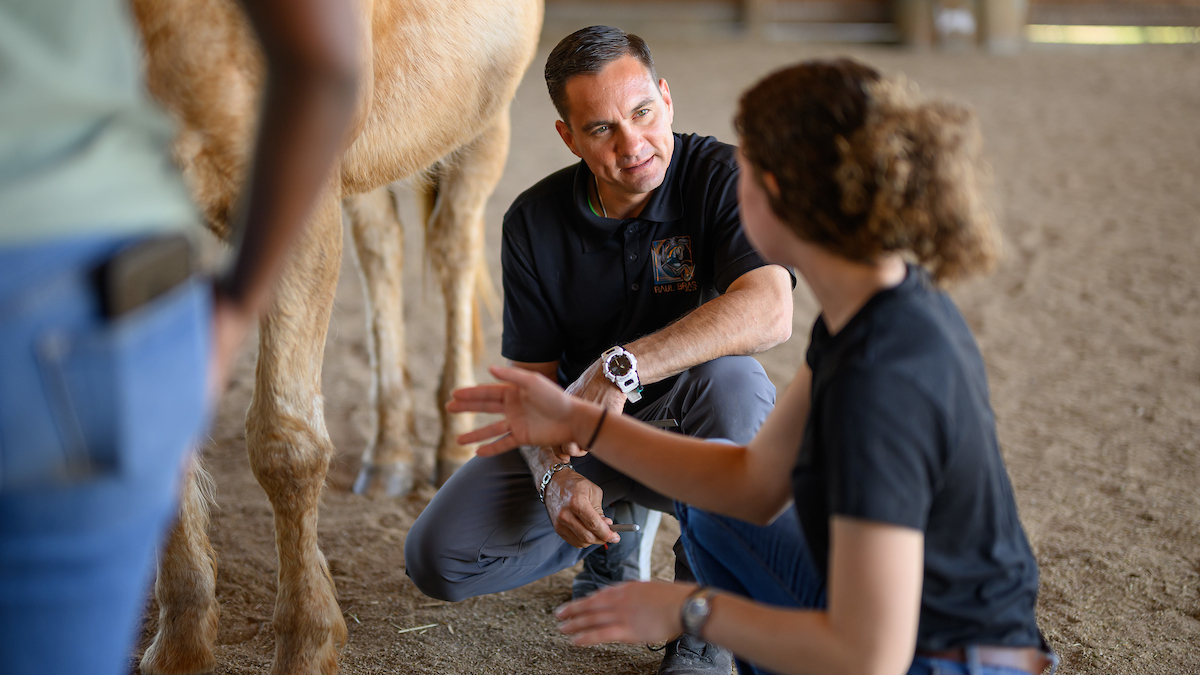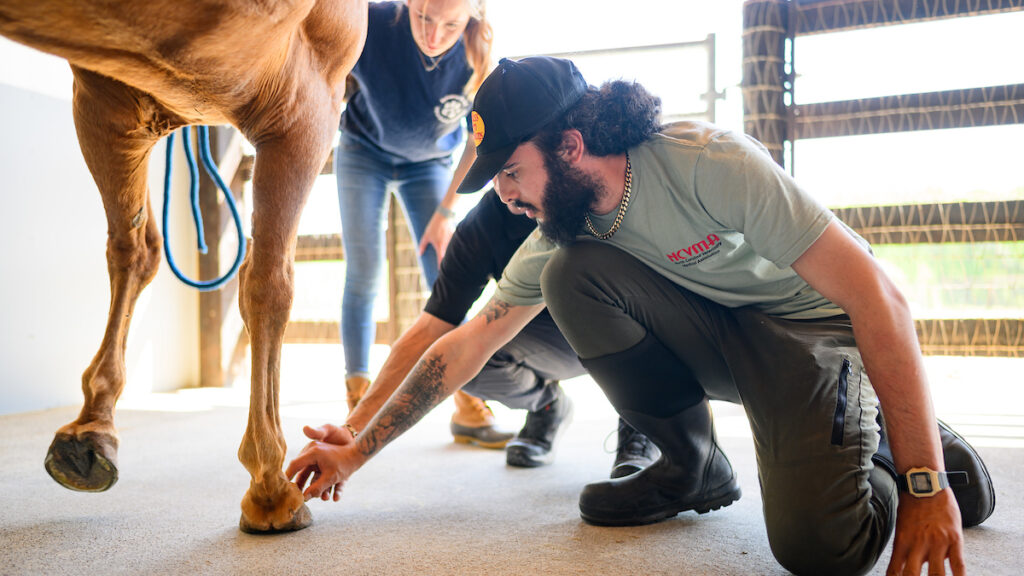Hoofin’ It: NC State Students Get World’s Finest Farrier Expertise
The trainees in Dr. Raul Bras’ farriery selective learn how important hooves are to horse health before heading out to build relationships with local partners.

It’s hands-on, knees-on and elbows-on teaching as Dr. Raul Bras crouches on the barn floor, wrapping his fingers around a standing horse’s hoof and explaining to veterinary students how to use a Sharpie to mark its widest part.
The world-renowned equine podiatrist, a veterinarian who arrived as a clinical practitioner at the NC State College of Veterinary Medicine in October, is leading the first day of the weeklong farrier selective. Selectives are intensive classes that students choose after finals each semester for specialized learning.
With his nose inches from the concrete, Bras is showing the students how to calculate where a horse’s coffin and navicular bones are inside the hoof. The goal of this selective is to teach prospective equine veterinarians how best to partner with farriers, craftspeople focused on hoof health and horseshoeing, for the good of a horse’s well-being.
“So this first day, we’re kind of giving them a jumpstart,” Bras says. “Everybody in this selective is a first year, so one of the things that we try to do is relate what they have learned in first-year anatomy and try to put that together with the actual work.”
Isabelle McMullen, one of eight students taking the class, hopes to be an equine veterinarian when she gets her degree in 2027.



“We definitely need more equine vets, and this is such a great opportunity to learn from Dr. Bras because he is amazing,” she says. “Equine work is such a unique part of veterinary medicine because horses are the only large animals who are a part of your family and like your pet. I mean, I would do anything for my horse.”
Particularly over the past decade, there has been an increasing recognition of complex equine foot issues, and the NC State College of Veterinary Medicine recruited Bras to elevate the college’s expertise in hoof health and its partnerships with the equine community in North Carolina.
The state is home to more than 300,000 horses, and the equine industry contributes about $2 billion to the state’s budget each year. Last fall, state lawmakers approved contributing $70 million to expanding NC State’s Large Animal Hospital and including a new Equine Veterinary Center.
Those expansion plans are one of the things that attracted Bras to NC State, where he is fulfilling a dream of working with veterinary students and helping them pursue equine medicine.
On the first day of the spring selective, Bras spends a couple hours in a conference room familiarizing the students with the tools of the farrier trade before taking them to the NC State Reedy Creek Equine Farm barn and asking them to assess the gaits and hooves of four horses, with two students on each.
Spend 30 minutes jotting down your observations, Bras tells them, and then be prepared to share them.

Katy Hagopian of Raleigh and Cici Sullenger of Chapel Hill take turns walking Olympia, noting whether the horse appears pigeon-toed or distributes its weight evenly before looking at its hooves. Both young women also hope to be equine veterinarians when they receive their DVMs in 2027.
“This is the white line separation,” Hagopian says, referencing where the unpigmented horn of the inner hoof wall joins the horn of the sole. “Would you agree?”
“In my friend’s horse,” Sullenger says, “it’s more a deep rut than it is out.”
“You can definitely tell she lands laterally because it’s so much more worn,” Hagopian says. “It’s shorter here and more worn.”
“Oh, you’re right,” Sullenger says. “I can see what you’re talking about.”
The back and forth of students learning from each other is repeated through the pairs as Bras and Kate Fiebrandt, an equine technician who has been at NC State 14 years, walk among the eight to answer any questions.
“We want our students to be able to speak the language of the farrier, to understand things that farriers are capable of,” Fiebrandt says. “It’s a very important relationship to treat all aspects of a horse. Veterinarians aren’t there to do the trimming and the shoeing, but they can work together to solve problems. We really want them to understand how to build those relationships in a way that works well for everyone.”
For the next four days of the selective, the students ride on calls with local farriers, whom Fiebrandt is quick to praise for partnering with NC State to give the future veterinarians invaluable experiences.
Circulating among the students at NC State Reedy Creek Equine Farm, Bras stops to share his expertise and encouragement with Hagopian and Sullenger as they work to calculate the locations of Olympia’s coffin and navicular bones.
“Did you remember that I told you about that 40-degree bone angle?” he asks. “And I told you to lower a little bit. Look, you were almost right there. You start these thought processes in your mind, putting your hands with your eyes and your brain, and then they all synchronize. Good job. Very good job.”



The women laugh, congratulate each other and take in the kind words from Bras, who was inducted into the International Equine Veterinarian Hall of Fame in 2015.
“I’m just so impressed that NC State hired someone like him,” Hagopian says. “I think that speaks a lot to our facilities and the people who work here. It’s really cool to have him as a resource, not just a podiatrist. It shows we’re one of the best, and that’s pretty awesome.”
- Categories:


